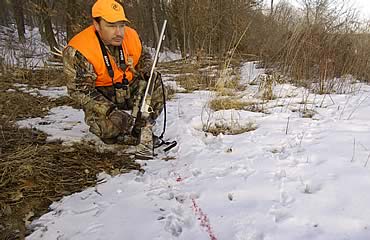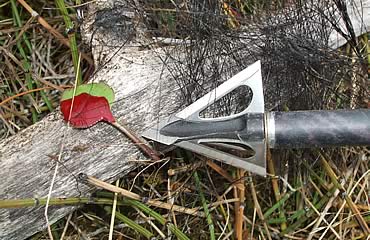Whether or not you recover a deer often depends on what you do right after the shot.
There’s an old lover’s proverb that says you can’t lose something that you never had. No question, tracking wounded whitetails is an ordeal every hunter worth his salt lick must confront. While there are no shortcuts to a quick recovery, there are some tactics that can boost odds immensely. And some new accessories promise to help the most handicapped tracker — including the colorblind. Let’s get tracking!
First Things First: Russell’s Rules
Buckmasters Editor in Chief Russell Thornberry is the best source for tracking and trailing wounded bucks I can think of. I’ve learned more hard-core whitetail lore from him over the years than from anyone else. The following interview gives hunters the basics they need to build the foundation of a solid game plan.
“There are a couple of scenarios that tend to confuse people,” Russell began. “I’m thinking of a hit high on a dorsal (on top of the spine). A bullet landing here will drop a buck like a stone. The assumption is, ‘Great, I’ve dealt him a lethal blow!’ Truth is, in 30 seconds that buck will be up and gone if you don’t finish him off right away. Another puzzler is the brisket shot. We get misled by the prolific bleeding — for up to 100 yards. But then all of a sudden there’s no more blood. I mean nothing. I don’t ever remember recovering a buck that got sliced in the brisket.
“A key factor is how a deer responds to the shot. That gives me a good idea of how to proceed. I always try to keep my wits and read a buck’s body language at the shot. For example, liver and gut shots make deer hunch up, and they generally don’t leave in a real hurry; they just sort of wobble off. It’s best to leave these animals alone. They can take up to 24 hours to expire. If you keep pushing them, they will surely die … but probably in the next county.
“Now a classic lung shot makes deer kick up their hind feet like a wild stallion. You should find bubbly, frothy blood. You’re going to see that deer fairly soon.
“Heart shots with bow and gun are a different story. Deer with these hits fire out of the block and take off like the wind. In fact, there might not be any visual sign of a good hit.
“I also look — especially if I wasn’t the person taking the shot — for hair, particularly the length and color. This helps reveal where you hit the deer. Shorter hair is lower, such as the brisket; lighter, even toward white, is a belly hit; and long, coarse hair means a hit higher on the body — the longer it is, the higher the hit.
“Weather always influences how I respond to a shot. In winter, falling snow will cover the trail (or the buck itself). This forces me to push the buck and try to keep it bleeding. One time, a hunter I guided in Alberta shot the leg off a deer, and we pushed it hard. The next afternoon, we caught up with it and finished it off. A testimony to how tough these critters can be is that this animal’s ears were frozen solid! Earlier in the fall, however, I would have left a deer hit like that because it would have bled to death with the severed leg artery. Rain also forces you to take your chances and follow the deer. But be warned: It’s an uphill business with bow and arrow since you won’t be as effective in putting down a jumped deer.”
 Okay, Some Questions:
Okay, Some Questions:
JM: Do you always stick to a blood trail to the bitter end?
RT: There isn’t a simple answer. It depends on the terrain and how knowledgeable I am with how deer react in a particular area. In some places, I can go to the graveyard and the deer will be there. But if you have a good blood trail, why not take advantage of it?
JM: Any tricks deer pull that can throw you off?
RT: Yes. Beware of the fishhook — a buck’s tendency to loop around to get downwind of his pursuer. When they’re hurt, deer expect something to follow them, so they try to set themselves up to use the wind and terrain to full advantage.
JM: Should you always wait the proverbial 20 minutes to a half-hour on a good hit?
RT: There is no downside to waiting, but there can be trouble with looking right away. If you get an audio clue, such as hearing the deer drop, fine. Go after him. But be sure you know what you heard.
JM: What about generalities — deer always go to water, always go downhill ...
RT: Sure, but there are always exceptions. I will say this about trailing wounded whitetails: You will find out more about where a deer lives when he’s dying than when he’s alive. The best training ground on scouting a big buck is the dedicated tracking of a wounded one. You’re going to learn some uncanny things, too — like how a wounded buck will invariably go where there’s the greatest concentration of tracks. It will look like a stampede with so many tracks everywhere. I don’t know if this is instinctive or what.
But, yes, most deer will usually end up going to water if they make it there. Uphill? The biggest buck I ever shot, all 321 pounds of him, ran up a side hill after my arrow sailed through him. I talked myself into thinking I shot too far back, and when he quartered uphill I thought that confirmed it. Turns out, he died less than 40 feet from where I’d last seen him. He’d circled back down the hill when he realized he was too weak to go any farther. So if you see a buck heading up a hill, don’t assume he kept going uphill.
JM: Some say a deer will tend to head in the direction that the entry wound occurred on his body — left side, travel to his left. What do you think?
RT: I haven’t noticed that, but I haven’t looked for that, either. I think direction is mostly about geography. I’ve had plenty of deer make big circles. But they all have one thing in common: They want to get back to where they came from — where it was safe.
 Blood-trailing Trickery
Blood-trailing Trickery
Let’s assume you understand everything you’ve read above. You just shot a deer, you marked where you saw it last, and you’ve got some blood in front of your boots. To get to this point you might have had to place a hat where you took the shot, and you wisely memorized the last rock, branch or stump where the deer disappeared.
To begin with, be careful not to walk over the blood trail. Second, don’t let anyone “circle ahead” just in case “the deer isn’t very far away.” Murphy’s Law says your helpers will surely trample the evidence you’ll need to make the recovery. Resist the temptation to make quick work out of a chore that takes time. The only exceptions are if you see the deer lying stone cold dead on the ground, or you’re 100 percent certain you heard it fall (and didn’t hear it get up). Absent these scenarios, the only time I’d abandon a blood trail is when it evaporates.
Now it’s time for some paperwork — unravel about a foot of toilet paper. I have recovered dozens and dozens of deer with this uncomplicated system, and the harder the trailing, the easier TP makes the task. The plan is to place a wad along the blood trail at chest to eye level — much like you would use reflective tape to mark a trail for in-the-dark travel.
Toilet paper is the perfect medium; it’s biodegradable, easy to see and simple to use. More important, it gives you a historical reference (where you’ve been) to hopefully tell where you’re going. Again, it’s very simple. Each time you reach a possible fork, check your back-trail to get a quick line of reference. But don’t forget Russell’s advice about fish-hooking.
What if the blood turns from drops to droplets and the sign is farther and farther apart? Because you can’t afford to miss a single clue, it’s time to slow down. If you are the antsy type, turn over the reins to someone who has one of God’s greatest gifts, patience. You might have to get on all fours to make any headway, too. Two assets at this time are light and magnification. It’s amazing how one person can see something that isn’t there to another. The powers of observation might be genetic to some degree, but it’s also a learned skill.
Back to your deer. You are still confident the hit was a good one, so you stick to the trail. But the harder you look, the more difficult finding more blood becomes. It’s time for a mono-scope, such as the Minoscope from Minox. Because this type of optic focuses in very tight quarters, thanks to its macro feature, you can tell female ants from a male ant. Well, that might be stretching it, but you get the picture. Point being, you can’t afford to miss any blood-related clues if you can help it.
Now nightfall is setting in. You have to make a decision. You can continue the chase with a light, but be forewarned that the batteries usually don’t last very long. A simple alternative is a Coleman lantern, which I have used for three decades and still rely on. A new option is the Bloodhunter from Primos Hunting. With a burn time of 1 1/2 hours, you get a unique “combination light” of red over green (yellow) that reportedly makes red blood drops stand out against the background.
Okay, now it’s final decision time. It’s getting late. Should you forge ahead or wait for daylight? Go for it only if you have plenty of energy and you can still focus. Lacking these partners in your corner, you’re better off getting a good night’s rest and resuming the hunt in the morning. Besides, there might be some howling coyotes or cackling ravens to guide you to your prize. When you return, be sure to bring your handheld GPS. It comes in handy if you run out of blood and you need to establish search grids with buddies. On several occasions I’ve found paunch-hit deer with this method. I hate to give up a trail, but if it gives up on me, I won’t quit looking ’til I’m done looking.
No doubt there will be episodes that defy logic and leave you scratching your head like a patient trying to read the handwriting of a doctor’s prescription. But this game plan works. I know, because hunters keep calling me each fall to help them find their deer. Usually, we do.
Read Recent Articles: • Never Say Never: How even a 65th year of hunting can be the best you’ve ever had.
• One in a Million: What causes the various mutations like albinism in whitetail coats?
• Confessions of a Trail Camera Hater: New technology isn’t always good, but trail cameras are one tool that’s here to stay.
This article was published in the Winter 2008 edition of Buckmasters Whitetail Magazine. Join today to have Buckmasters delivered to your home.